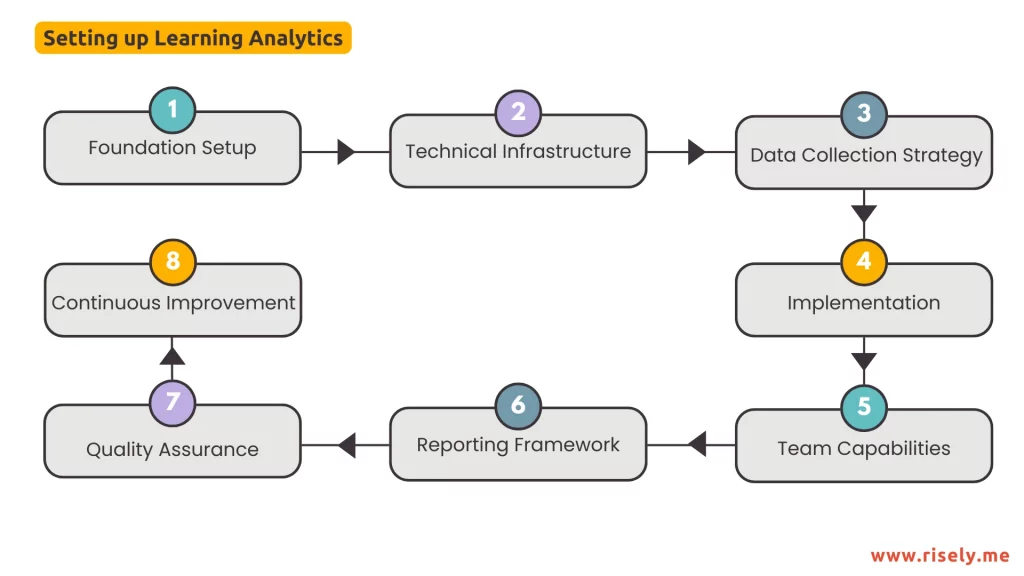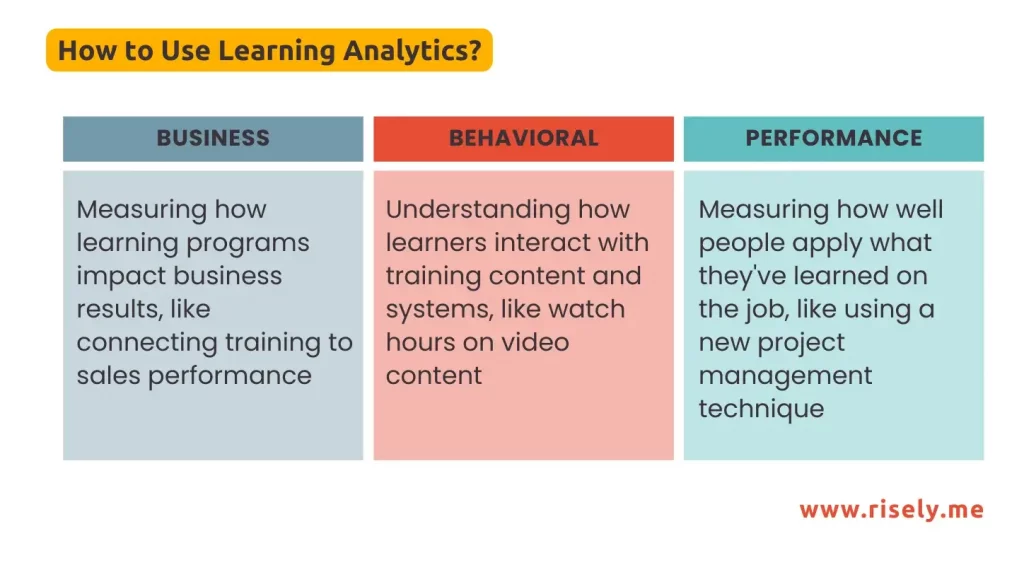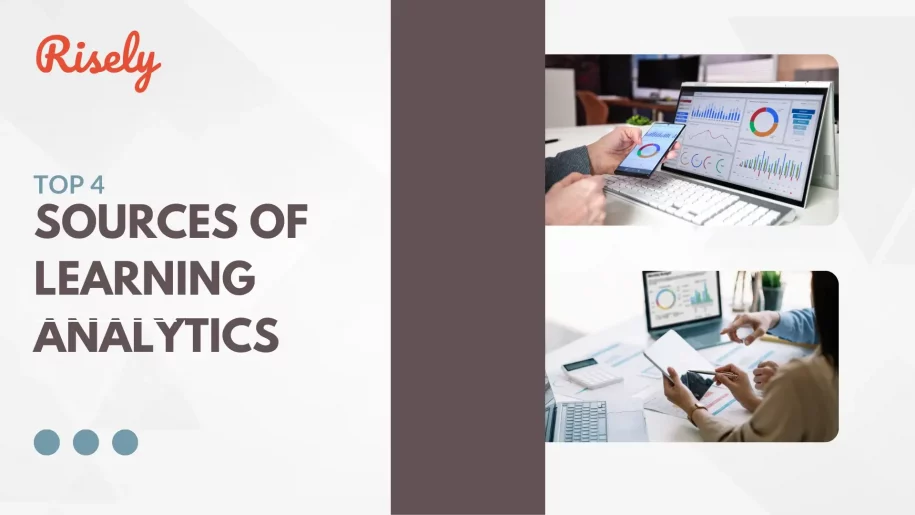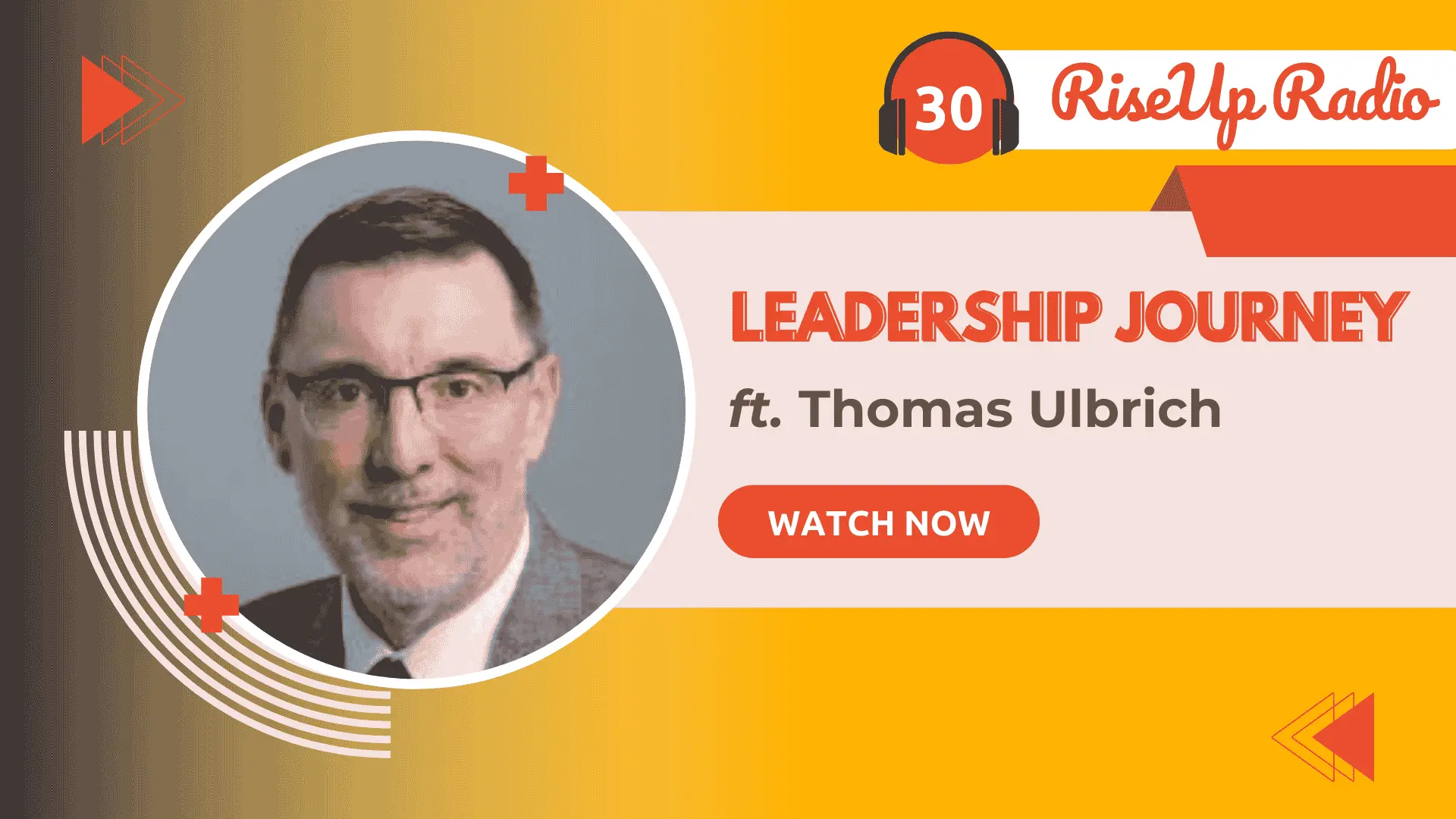What Are Good Sources Of Learning Analytics?
Learning analytics are critical to answering several questions for L&D teams. You need them to support the overall learning and development strategy, define the business case, and prove your impact. But there’s a lot of noise when measuring L&D initiatives. As a result, we must ask what the right sources of learning analytics are for us. In this blog, we will try to uncover learning analytics sources that make your L&D practice data-driven.Let’s Recap: Learning Analytics
Learning analytics is a field that connects learning and data science. It involves measuring, gathering, analyzing, and sharing data from your employees. This data includes information about learners, like their backgrounds, job challenges, engagement, and learning styles.
- Are we moving the needle? – Thinking in terms of positively impacting the business and the people.
- Where are people getting stuck? – Problem solving for your team.
- Which skills need urgent attention? – Determine priorities.
- Is our learning approach working? – Support consistent improvements.
- Are we spending wisely? – Ensure cost-effectiveness of L&D.
- What do people actually use? – Understand and meet the needs of your people.
- Where’s our biggest impact? – Gather your strategic impact.
What Sources of Learning Analytics Should You Track?
Now that we have looked at learning analytics, let’s check where this useful data comes from. Learner data comes in different forms. Each form gives special insights into the learning process. By using various data sets, you get a clear view of learner engagement and how well they are doing overall.Engagement Data
These sources of learning analytics will primarily report the engagement level with learning content. It helps you track how your learners navigate the systems, mostly collected through LMS and similar platforms. It includes metrics like:- Course completion rates
- Time spent per module
- Assessment scores
- Drop-off points
- Login frequency
- Resource downloads/views
Skills and Competency Data
The second set of learning analytics sources is data about skills and competencies that your people are working on. These are measured through assessments and evaluations, which can come from multiple sources, including platforms’ in-built assessment systems, feedback from managers, and job performance, etc. to name a few. Others include:- Pre/post assessment results
- Certification rates
- Skill gap analysis
- Performance reviews
- Manager feedback
- Self-assessments
Program Efficiency
The third area, tracking the efficiency of learning and development programs, helps you evaluate and improve L&D practices. Based on these, you can make improvements, such as enhancing the content quality or cutting down on administrative tasks by automating functions. It includes tracking of learning analytics metrics such as:- Cost per learner
- Time to competency
- Resource utilization
- Admin time spent
- Support tickets
- Technical issues
Business Impact
The last sources of learning analytics we are highlighting include conversations about the business impact of learning and development. The metrics in this section track impact across many vital business areas. Importantly, we also consider the impact on customer interactions, going beyond the scope of L&D teams and learners. This section is vital because it relates directly to the budgets and resources you can avail yourself of for your L&D plans.- Performance metrics before/after
- Error rates
- Customer satisfaction
- Employee retention
- Promotion rates
- Project success rates
Other Interesting Reads
How to Use Learning Analytics?
Descriptive analytics and diagnostic analytics are basic methods in analytics for learning and development. They help us understand what has happened and why. Descriptive analytics looks at past data. It summarizes this data to find trends and patterns. For example, it can show which courses have the most learners or which learning resources people use the most. This helps us see past behavior and make better choices for the future. In contrast, diagnostic analytics digs deeper into the data. It looks for reasons behind trends or patterns. For instance, if descriptive analytics shows that students are less engaged in an online discussion forum, diagnostic analytics can help find out why. Is it because the topics are uninteresting? Are there technical problems with the platform? Or is the forum not matching how students like to learn? Predictive analytics goes beyond learning analytics by using past data to predict future results. In L&D, this helps find employees who may struggle or those who could do very well. By looking at trends in previous learner data like test scores, engagement, how they engage with learning platforms, we can spot important signs of employee success. For instance, if a predictive model shows that learners who often score low on early quizzes tend to have more trouble in their work, trainers can use this to help those employees earlier. Research keeps looking into how predictive analytics can help with challenges such as keeping employees engaged, creating personalized learning paths, and making effective programs for employees or skills at risk of falling out. Prescriptive analytics builds on what we learn from descriptive, diagnostic, and predictive analytics. It recommends actions to help improve the learning process. It does more than just point out problems or predict what might happen; it offers specific steps educators and schools can take to boost results. For example, if predictive analytics show that some learners might struggle, prescriptive analytics might suggest solutions like personalized tutoring or pairing employees with peer mentors. It could even recommend the best time and way to provide these interventions based on each employee’s unique learning style.
Some concerns in using learning analytics data
The use of learning analytics is getting more common, but it comes with challenges and important ethical questions. L&D professionals must deal with these issues in a responsible way. You need to think about data privacy, security, and fairness. It is essential to avoid any biases that may arise. First, workplaces are responsible for protecting learner data. You must keep this information private and safe. You should also use what they learn from learning analytics to create fair and inclusive learning spaces for every employee. Being open about data use is key. Employees should know what data is collected, how it is used, and why. Safe data storage is also very important. Predictive analytics can be very useful for helping employees do better. However, it also brings up some ethical concerns that we need to think about. One major worry is bias. If the historical data used to create predictive models shows biases that already exist in the learning and development strategy, these models might repeat or even worsen those biases. For example, if a model often flags learners from certain socioeconomic backgrounds as “at risk,” it could generate unfair or wrong predictions. This would only add to the existing inequalities.Wrapping Up
The area of learning analytics has many success stories. Companies are now using analytics tools and learning analytics systems to check how well training works. They help improve how content is shared and make the learning experience better for workers. By looking at how employees engage with training materials, testing what they remember, and collecting feedback on the training, companies can find ways to improve. They can adjust content to fit specific job needs or skill gaps. Learning analytics dashboards give valuable insights into how employees learn. This helps training and development teams create more engaging and effective programs that support business goals. As companies rely more on data, the use of learning analytics to improve worker training and growth will keep increasing.Ready to elevate your team’s learning and development journey?
Grab your free copy of Risely’s learning and development strategy framework and get started.
How to Build a Leadership Journey? ft. Thomas Ulbrich
How to Build a Leadership Journey? ft. Thomas Ulbrich Effective leadership doesn’t always begin with a grand vision. Sometimes, it…
AI and Leadership Development: Driving Synergy for Growth
AI and Leadership Development: Driving Synergy for Growth You know the frustration all too well. Your organization invests thousands in…
How Are AI Learning Platforms Transforming Leadership Development?
How Are AI Learning Platforms Transforming Leadership Development? As an L&D leader, you’re likely familiar with this frustrating reality: 82%…
5 Essential AI Skills for L&D Leaders
5 Essential AI Skills for L&D Leaders According to LinkedIn’s 2025 Workplace Learning Report(1), 71% of L&D professionals are now…
How to Create a Course with AI: A Guide for L&D Professionals
How to Create a Course with AI: A Guide for L&D Professionals According to a McKinsey survey(1), only 11% of…


